Coolwire
Issue 5: January 2003
Greenhouse, global warming, climate change,
IPCC events, news, articles, mostly from the Internet & email
groups, much of which will never find its way to mainstream media.
The idea is to post new material as soon as it comes to hand and maybe close
off issues each month. Feedback and articles
to climate@webace.com.au please.
I trust all the original authors are acknowledged,
I have tried to include url's to their sites where available. |
Contents in order:
Ray Evans on Castles & Henderson crit. of IPCC
ABC radio interviews Dr Ian Castles
Great Lakes freeze over
50 US Antarctic people get hom sooner.
North Korea reduces electricty waste
Bob Foster points out how 9/11 and Osama relates
to Kyoto.
WWF links Australian drought with "Global Warming"
The Economist weighs in to Castles / Henderson attack
on IPCC silly scenarios. |
Has anybody got an english translation of the article
?:
Falsche Modelle Keine Klimakatastrophe
Drohende Klimakatastrophe? Mitnichten! Das Intergovernmental Panel on
Climate Change (IPCC) schürt Angst mit falschen Zahlen, sagen zwei
renommierte Ökonomen, der Australier Ian Castles und der Engländer
David Henderson.
From: http://www.wiwo.de/pswiwo/fn/ww2/sfn/buildww/cn/cn_artikel/cn/bm_morec
ontent/id/156/id/14528/fm/0/fl/0/bt/2/SH/0/depot/0/index.html
Ray Evans of the Lavoisier Society comments
on the Castles - Henderson critiques of the IPCC.
Two pdf files for download, 125 kb main comments 20
kb flowchart diagram.
ABC Economics Correspondent Ian
Henderson interviews Dr Ian Castles on ABC radio PM.
Global warming projection based on unsound figures:
statistician
PM - Monday, February 17, 2003 18:15
MARK COLVIN: There's a new question mark over
the extent of global warming today; it comes in the form of calculations by
the former head of the Australian Bureau of Statistics, Ian Castles.
He's been going through the figures and assumptions
made by the International Panel on Climate Change, and Mr Castles says the
economic assumptions made in its two-year old report on global warming are
simply wrong.
The forecasts for a severe warming of the earth's
surface are tightly linked to economic assumptions, so Mr Castles says his
economic analysis casts severe doubt on the scientific predictions.
Economics correspondent Ian Henderson.
IAN HENDERSON: Do you believe that, by the end
of the century, developing countries like Zimbabwe, Thailand, Panama, Papua
New Guinea, Fiji, Vanuatu and Samoa will all be enjoying average incomes
that are higher than Australia's?
If not, then you should be very wary about the
International Panel on Climate Change's forecast that, mainly on account of
human efforts, the world will be up to 5.8 degrees warmer in 2100.
Former Australian Statistician, and former head
of the Federal Finance Department, Ian Castles, certainly does not accept
at face value the economic assumptions behind the IPCC's 2001 global warming
report.
Assumptions like the ones that would see a host
of relatively poor countries overtake Australia's per capita GDP within this
century, and that's led Ian Castles to seriously question the official forecasts
of greenhouse gas emissions, and of global warming.
IAN CASTLES: In order to make projection of emissions,
it's necessary to begin by projecting what's going to happen to the world
in the next century, in terms of the real levels of output; how many power
stations, how many people around the world are going to have access to electricity,
what are they going to use it for.
IAN HENDERSON: Ian Castles objection is that the
group putting together the official estimates of growth have got their GDP
figures seriously wrong for the developing world.
IAN CASTLES: They've assumed, in fact, that the
gap between the rich countries and the poor countries of the world is a good
deal wider than in fact it is.
They have then developed a series of scenarios
that assume that the gap is substantially closed in the course of the century,
and this involves them in making projections in the growth in output in the
developing world, which are very high, in fact much higher than the rates
of growth that these countries have ever achieved in the past.
IAN HENDERSON: In a nutshell, the IPCC's experts
have used exchange rates to convert different nation's incomes to a common
base. It's an unsound procedure, according to Ian Castles, one of Australia's
most highly respected economists.
He says one example of the sort of economic assumption
made by the IPCC is the information it's put on a database about various
countries.
IAN CASTLES: Which shows, for example, that the
output of South Africa in the year 2100 will be greater than that of the
whole world in 1990.
IAN HENDERSON: If Ian Castles is correct, and
the IPCC's calculations of economic growth in the developing world are wrong,
then that means the IPCC's projections of carbon dioxide emissions generated
by economic activity are simply too high.
He concedes that forecasts like those the IPCC
has been making are very difficult to get right.
But he says that just means that economists, statisticians
and government economic policy-makers must play a much greater role in future
in the global warming forecasting business.
If Ian Castles manages to change the IPCC's mind
on its economic calculations, he says the organisation is likely to reduce
its forecasts for the extent of global warming.
IAN CASTLES: I think it's possible that if the
exercise had been done in the way it's been done, but avoiding the particular
areas to which I'm drawing attention, that the range of climate change will
be changed significantly.
I think it would certainly come down significantly
at the top end, the 5.8, and I believe it could also come down at the bottom
end, the 1.4 by perhaps as much as half a degree.
IAN HENDERSON: Ian Castles says the IPCC's projections
of emissions, and therefore of temperatures, are based on fantastic assumptions,
and his aim is to replace that fantasy with some solid reality.
MARK COLVIN: That one's certain to start a debate.
Economics correspondent, Ian Henderson.
Another in our "Blame it on Global Warming" series
Deep winter freeze coats three Canadian Great Lakes
By MARTIN MITTELSTAEDT
From Tuesday's Globe and Mail
For the first time in years, the entire surfaces of Lake Superior, Lake
Huron and Lake Erie have
frozen over, according to ice experts at the Canadian Ice Service
of Environment Canada.
This winter rarity usually occurs only once a decade, and only for fleeting
periods, with the last two big freezes in 1994 and 1982.
"They're all covered with ice. They're 100 per cent covered. That's
quite unusual," said Claude Dicaire, senior ice forecaster for the Canadian
Ice Service.
The Great Lakes region is not alone in having massive amounts of ice.
The Gulf of St. Lawrence has 25 per cent more ice than normal, and the Atlantic
coast down to Halifax is covered with sea ice, a tribute to the intensity
of the deep winter freeze that has gripped Eastern Canada.
Ice extending as far south as Halifax in the Atlantic is considered
as unusual as shoreline-to-shoreline freezing of some of the Great Lakes.
Mr. Dicaire said Lakes Superior and Huron froze over for the first time this
year on Feb. 27, a finding based on satellite images.
The two massive lakes — the world's second- and fifth-largest by surface
area — usually have ice-free areas all winter because the huge volumes of
water in them seldom cool enough to allow surface temperatures to drop to
the freezing point.
The colder weather that has led to the ice has had other effects. In
Eastern Canada, it has helped the skiing and snowmobile industry, which are
having one of their best seasons in years.
But the cold has hit homeowners with bigger heating bills. January and
February has been 34 per cent colder in Southern Ontario than the same period
last year, leading to skyrocketing costs for home heating.
Even the maple-syrup business is having trouble getting off the ground
because it is too cold for the sap to run. "We're not doing anything," said
Ken McGregor, who has a sugar bush near London. "It's just way too cold."
Ice is not unusual on Lake Erie, the shallowest and most prone to freezing
of the Great Lakes. It has been covered by a sheet of ice since late January,
and usually freezes rapidly because it is quick to cool.
Lake Ontario, a deep, relatively southern lake, almost never freezes. It
is mostly open water, except for an ice-covered patch in its northeast corner,
according to satellite images. In Lake Michigan, the only one of the Great
Lakes entirely in the United States, the northern third is covered with ice.
Most of the ice is 40 centimetres to 60 centimetres thick, though some
places on Lake Huron and Lake Superior have ice about 70 centimetres thick.
Mr. Dicaire said the ice is so extensive he expects it will take until the
end of April for spring temperatures to thaw the lake surfaces.
The ice has created havoc for shipping and ferry companies. The St.
Lawrence Seaway is to open on March 25, but it is not certain that conditions
in the lakes will co-operate. "We've informally talked with coast-guard
people and the seaway people, and it's quite likely that that may be delayed
a few days due to ice conditions," said John Falkingham, chief of forecasting
operations for the Canadian Ice Service.
John Misener, a retired Great Lakes ship captain who spent decades
on the lakes, said he has taken freighters through late-season ice, and
the experience was not enjoyable for the crew or good for the vessel. "The
ice damages the ships to a certain extent. It's tough to get through
It's far better to wait for two or three weeks and see if the thing reduces
itself with a good rain."
On the East Coast, Mr. Falkingham said ferry service between Sydney,
N.S., and Port aux Basques, Nfld., has been experiencing difficulty because
of the thick ice. A ferry spent part of Sunday caught in ice about 38 kilometres
off north Sydney and had to be helped by an icebreaker. But Mr. Falkingham
said the thicker ice will be good for seals, mammals that require firm ice
to give birth and to nurse their pups until they can swim. Last year,
the Gulf of St. Lawrence had so little ice that many pups drowned after their
mothers were forced to give birth in open water.
The ice in Eastern Canada is due to temperatures that have been
below normal since January, with hardly a hint of the warming trend that is
normal for this time of year. On Monday, the forecast highs in
Southern Ontario were about -11, compared to an average for early March of
3. And last week, the mercury dipped to -25 in Toronto, the coldest March
day in much of Southern Ontario in more than a century. "We had never seen
a colder day in March since 1868. That is really phenomenal," said
David Phillips, Environment Canada's authority on weather trends.
The other unusual weather this winter has been the lack of rain and
snow. According to Mr. Phillips, the entire Great Lakes-St. Lawrence region
from Windsor to Quebec City has had the lowest precipitation on record.
He said the colder temperatures have masked what would otherwise be recognized
as a severe drought.
Nonetheless, the winter has been tailor-made for those who enjoy ice,
with lengthy periods where the temperatures have not exceeded 0. Even
Toronto, a city with frequent winter thaws, has had 63 days in which temperatures
failed to rise above 0, more than double the number last year, according
to Mr. Phillips.
RNZAF Hercules saves 50 American Antarctic Personnel from
wintering over
Unusually thick sea ice has prevented a US fuel tanker getting
near shore to deliver fuel to US and NZ Ross Sea bases. For full story see
NZ Herald web site. www.nzherald.co.nz where else would ya go
for news.
The point of this story is that if it was reversed and
a lack of normal ice had prevented something, it would have been grabbed
by the usual "green - media" suspects as evidence of "global warming".
Two Korea's, China, Japan at night
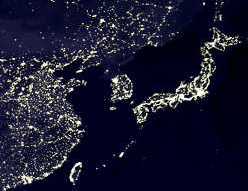 North Korea leads way to Kyoto.
North Korea leads way to Kyoto.
This segment of NASA's Earthlights image sent in by North Korean Supreme Council
for Community Prosperity and Energy Efficient Grass Clipping Recipes, shows
stunning success of Peoples Socialist Economic Planning. Unlike in Capitalist
Slave countries, People only have to forage for food in daylight. Also Wise
Leader say Air Force find Capitalist Running Dog targets easy.
For other global Earthlights images follow my Front Page
links
The Kyoto Protocol: politics and the 9/11 watershed
by Bob Foster
15 January 2003
The Kyoto Protocol marked the beginning of a new era. Up until the
end of the 80s, fear of the Soviets had provided the glue which held the
Atlantic Alliance together. But Ronald Reagan’s triumph over Soviet
Socialism sowed the seeds from which has sprouted the era of cross-Atlantic
competition.
The new Battle of the Giants is an intra-Alliance struggle for world economic
domination; no talk of ‘science’ here. This undeclared war is Transatlantic,
and its protagonists are the EU and the US. The Kyoto Protocol would,
when ratified by both protagonists, have begun a slow-but-sure process of
weakening the US economy relative to that of the EU – and hence, have begun
the (long) process of transferring world economic leadership to the Europeans.
There would have been serious collateral damage, of course, particularly
to the economies of Canada and Australia. But there also would have
been some spectacular winners, particularly Russia and some other FSU states.
But since the zenith of its achievement, at Kyoto in 1997, the prospect
of EU world economic domination has begun to recede. The EU is a rising
star on the way down.
The first giant blow to the EU was Al Gore’s narrow loss in the 2000 election,
even though he played the Greenhouse Card to the hilt during his campaign.
If Gore had won, the battle would have been over before it really began.
But, although George W Bush showed early signs of recognizing the threat
posed to the US economy by ratification of the Protocol, how long could he
have held out? He had a bare majority (if any) of votes cast in 2000;
he did not control the Senate; and he had no legitimate mandate to oppose
Kyoto.
Enter stage left: Osama bin Laden. His 9/11/2001 horror was the second
giant blow. As a consequence, the Bush Republicans swept the mid-term
election in 2002 on the subsequent wave of nationalism - it was the best
mid-term result for an incumbent since 1908.
In 2002, George W went out and fought for his candidates; and this time,
the voters clearly endorsed him. The Republicans now hold both houses;
and W appears unlikely to emulate his father’s inability to achieve a second
term.
______________________________________________________________________________________
1. Phone (61.3) 9525 6335, fax 6345, email fosbob@bigpond.com.
Bob is a director of the Lavoisier Group at www.lavoisier.com.au which is
putting a contrarian view on climate change to that of the UN’s IPCC.
Like-minded Australian sites are www.webace.com.au/~wsh and the comprehensive
www.john-daly.com.
Crucially also, the US has acquired a much-needed new friend outside the
EU. Osama and the Chechens have combined to give Russia common cause
with the US, where none existed previously. Bush and Putin are an item
now - because of 9/11. I suspect both would be relaxed if Kyoto proceeded
with Russia in, and US out. Instead of the US competing for Russian
‘hot air’, the EU (and Japan) can have it all.
Of course, things change quickly in politics. But my guess is that
W feels electorally secure at present. If so, he will continue to ignore
the urgings of the New York Times and Washington Post, his own science-bureaucrat
advisers, the World’s Nobel Laureates and Academies of Science, France and
Germany, and even his good friend Tony Blair. It is Osama who has conferred
on W the stature he needed to not ratify the Kyoto Protocol.
On current knowledge, there is little chance of US ratification before
the 2008 election.
I hope I am wrong here, but it looks as though the Protocol’s longer-term
future (2008-12, and beyond) will evolve largely in response to economic and
political factors, not because its flawed science has caused IPCC to recant.
The EU has conned its voters on how painless Kyoto will be, to the point
where it now has little option but to proceed as if 9/11 never happened.
Therefore, it will be the EU whose economy slowly weakens, not the US as intended.
In particular, the prime sufferer now will be Germany - with Russia (selling
both natural gas and carbon credits) remaining the chief beneficiary.
How long can this charade last? Either a future US president will bring
the US into the Protocol (or more likely, into some face-saving and ineffectual
successor to it), or EU voters will ultimately wake up to their politicians
and bureaucrats. I hope for the latter outcome.
I doubt if Osama would have wished it so, but if Kyoto does indeed fail,
he may in effect save the lives of many unbelievers during future wintry extremes
in the Northern Hemisphere – when the Sun don’t shine, and the wind don’t
blow – by his help in keeping carbon-based energy available and affordable.
The watershed for the Protocol’s fortunes was 9/11.
Finally, Kyoto is supposed to be about protecting the environment.
But CO2 emissions are not ‘dirty’ or ‘polluting’ - as we are told ad nauseam
- but a vital promoter of both biodiversity and food production. Commercial
growers even add CO2 to the atmosphere of their greenhouses. In fact,
the greenhouse issue is already diverting money and attention from the World’s
real environmental imperatives.
The Kyoto Protocol is not about science, and it is not about the environment
– if it is averted, we will have to thank the new team – George W Bush and
Osama bin Laden.
"Global Warming" and the Australian
Drought
Over the last few months many media stories have made dubious claims that
the Australian drought is the "worst ever" or "worst in a hundred years".
From what I can see of long term rainfall trends many media claims do not
stand up to scrutiny and most data I have checked tells me that this drought
is just another cyclic El Nino related drought, similar to many Australia
has experienced as witnessed by our ~150 year data record. When 2002
rainfall data is to hand then we will see how the year compares to past droughts
at places where we have high quality long term data. The Murray Darling Basin
stream inflows for 2002 have been less than any year since the 1982'83 drought
according to the Govt. website www.mdbc.gov.au
Towards the end of 2002 dubious media claims got worse by linking the drought
with "Global Warming".
In January 2003 we have the World Wildlife Foundation (WWF) sponsoring
a paper, "GLOBAL WARMING CONTRIBUTES TO AUSTRALIA'S WORST DROUGHT",
available from the WWF as a pdf file download. It was also featured
on ABC TV 7.30 Report.
The salient point relied on by the authors is that March to November maximum
temperatures (=daytime) increased sharply in the 2002 in the Murray-Darling
Basin, see here their Figure 2 with the spectacular temperature spike.
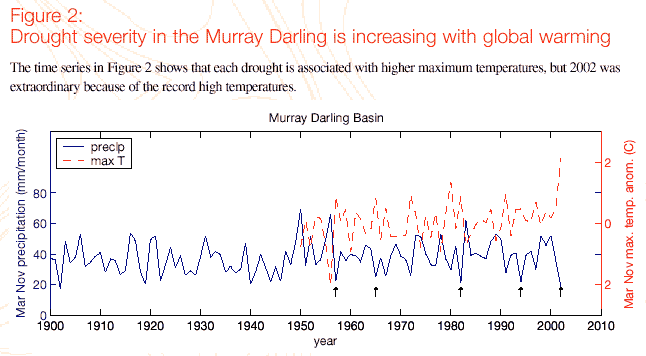
The authors should know that "Global Warming" is expressed as annual mean
temperature changes and trends, not as a function of "March to November daytime
temperatures". In our rebuttal of these silly WWF claims we first look at
the official IPCC "global warming trends", temperature anomaly data by Jones
et for two 5 degree by 5 degree grid boxes the western one on left covers
most of the Murray-Darling Basin while that on the right is to the east and
includes Sydney with the excessive urban heat island data contamination
there (see my cities pages for the Sydney story). While the IPCC is telling
us that the MDB has been cooling over 120 years, it seems a little strained
to make this connection between "Global Warming" and the 2002 drought. Graphics
of Jones et al data trends from www.co2science.org web site, with thanks.
| Murray-Darling Basin 5 degree grid cell bounded by
30 & 35 degrees South Lat. and 145 & 150 degrees East Long. |
Sydney-Hunter Region 5 degree grid cell bounded
by 30 & 35 degrees South Lat. and 150 & 155 degrees East Long. |
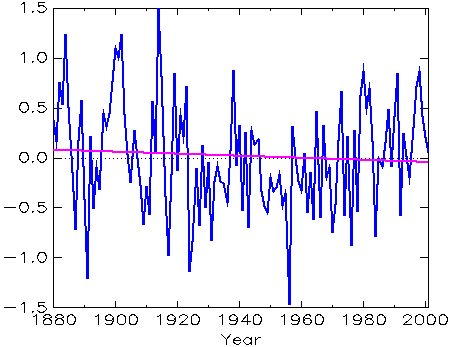
|
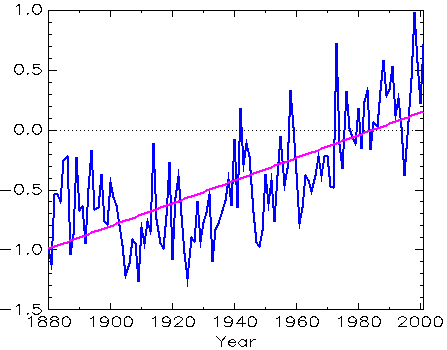
|
A quick perusal of Australian temperature station records updated
through 2002 from the NASA Goddard Institute of Space Studies (GISS) web site,
shows that 2002 was not a notably warm year in Australia.
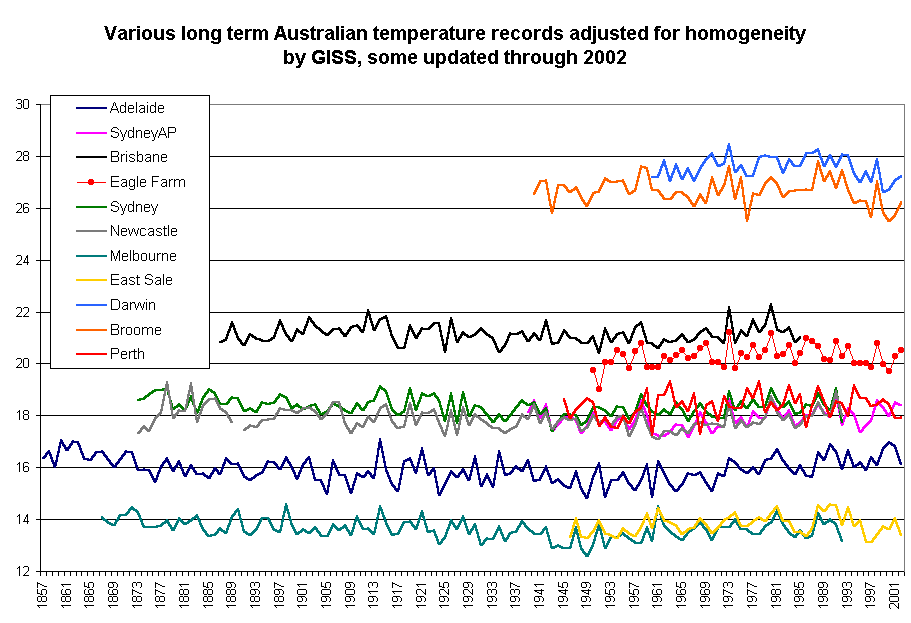
Long term temperature trends from the Murray-Darling basin give no comfort
to the "global warmers" either with the records from Hay, Deniliquin, Rutherglen
Research Station and Echuca all showing little trend or even (shock - horror)
cooling over a century. The only two MDB stations updated through
2002 by GISS, Mildura and Wagga Wagga show 2002 was not notably warm as the
Karoly / WFF paper contrives to show.
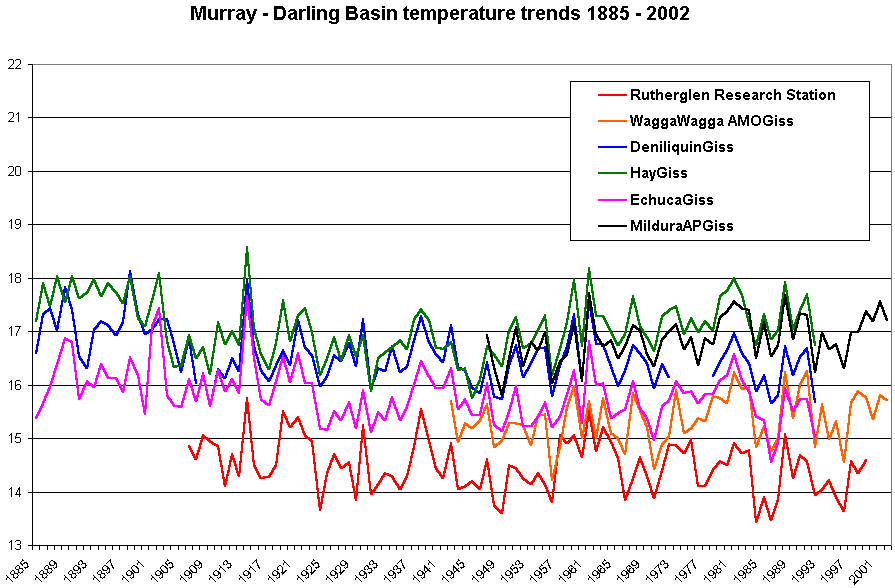
So the WWF claim turns out to be based on highly selective use of tweaked
and stroked data and they completely ignore "official global warming data"
generated by Jones et al and promoted for over a decade by the IPCC.
They also miss the point that as well as the effect of lower rainfall on
temperatures, greatly reduced irrigation flows in 2002 could well be
contributing to the increase in daytime temperatures at stations where
flood irrigation might normally mitigate hot days.
As usual, extravagant Green claims given uncritical coverage by a pliant media
go completely to water when the data is examined.
Coolwire has tried to keep readers up to date with progress
in the Castles / Henderson critique of IPCC modeling scenarios. Now
the "The Economist" has weighed in to say "... the IPCC had better check its
calculations". Sceptics have been saying this for 10 years and
not just the "scenario" calculations.
From
economist.com
Hot potatoFeb 13th 2003
From The Economist print edition
The Intergovernmental
Panel on Climate Change had better check its calculations
AT THE beginning
of 2001 the Intergovernmental Panel on Climate Change (IPCC) released, as
the main result of its massive Third Assessment Review, a set of figures that
have become the most-cited numbers in the field of environmental policy, and
quite possibly the most-cited numbers in any field of public policy. The
panel, whose task was to assess the extent to which emissions of greenhouse
gases may warm the planet over the coming century, reported that “globally
averaged mean surface temperature is projected to increase by 1.4 to 5.8°C
over the period 1990 to 2100.” This alarming conclusion has become the starting-point
for popular and official discussion of global warming and the policies that
might mitigate it. Bear in mind how expensive some approaches to the problem,
such as the Kyoto Protocol, might be if governments actually succeeded in
implementing them. Vast sums are at stake.
As a rule,
the IPCC is careful to attach warnings to its projections. Journalists are
impatient with that: they prefer “prediction” to “projection” (less vague)
and like to talk of temperature rising by “as much as 5.8°” rather than
quoting the full range. This is all very misleading—but the panel cannot
be blamed for the way its work is reported. What it can be blamed for is
the seriously flawed methods it has followed in making its estimates.
n recent months,
two distinguished commentators—Ian Castles of the National Centre for Development
Studies at Australian National University, formerly the head of Australia's
national office of statistics; and David Henderson of the Westminster Business
School, formerly the chief economist of the OECD—have put together a critique
of the panel's Special Report on Emissions Scenarios (SRES). The report claims
to “provide the basis for future assessment of climate change”, but Mr Castles
and Mr Henderson point to serious flaws in its analysis and results. Last
year they began writing to the chairman of the panel. Following an invitation
to a technical meeting convened by the IPCC last month, they have offered
further comments. The critique which thus evolved is to be published next
month*.
One key problem
with the IPCC's report, sufficient by itself for Mr Castles and Mr Henderson
to declare the document “technically unsound”, is the way the scenario-builders
have based their projections of future output on national GDP estimates which
have been converted to a common measure using market exchange rates. This
procedure leads them to overstate the initial gaps in average incomes between
rich and poor countries—because prices tend to be much lower in poor countries.
Those gaps are in turn crucial for the IPCC's projections, because the method
used in the scenarios assumes not only that the rich countries will continue
to get richer but also, in most of the 40 scenarios considered, that the
greater part of the (overstated) initial gaps between rich and poor will
be closed by the end of the century.
The combination
of overstated gaps and of built-in assumptions about the extent of convergence
in the average incomes of rich and poor countries yields projections of GDP
for developing regions which are improbably high. Even the scenarios which
give the lowest figures for projected cumulative emissions in the course
of the century assume that average incomes in the developing countries as
a whole will increase at a much faster rate than has ever been achieved in
the past.
Miracles and anomaliesThe unreality of
the assumptions about economic growth in developing countries is highlighted
by disaggregated projections which were recently released on the SRES website. These
projections imply that, even for the lowest emission scenarios, the average
income of South Africans will have overtaken that of Americans by a very
wide margin by the end of the century. In fact America's per capita income
will then have been surpassed not only by South Africa's, but also by that
of other emerging economic powerhouses, including Algeria, Argentina, Libya,
Turkey and North Korea.
The SRES summary
for policymakers tells anxious governments that the 40 scenarios “together
encompass the current range of uncertainties of future emissions”. Plainly,
this is incorrect. The panel's low-emissions scenarios make exceptionally
optimistic assumptions about economic growth in the developing world. But
it is impossible to say, without running the whole exercise afresh, what
the properly calculated range of projections for temperature changes would
be.
Mr Castles
and Mr Henderson offer a variety of other criticisms of the SRES, and of the
panel's treatment of economic issues more generally. They complain, for instance,
that history is too much neglected in the consideration of future trends.
They also point out that developments in the first ten years of the scenario
period, 1990-2000, were pretty clear by the time the SRES was published in
2000, and that in some respects they diverged substantially from the scenarios'
projections; yet the report pays them little or no heed. Mr Castles and Mr
Henderson argue that the circle of those involved in the climate-change exercise
has been too restricted. For the future, the panel should draw on a wider
range of economic and statistical interests and expertise. In particular,
where its member governments are concerned, there needs to be a greater involvement
of economic ministries and statistical agencies, alongside environment ministries.
The full panel
meets next week in Paris to review the preparation of its Fourth Assessment
Review. It should take the opportunity to consider the Castles-Henderson critique
and resolve to do something about it.
Here at Coolwire
we will not be holding our breath.
You read it first here
Return to Coolwire index
Back to Global Warming
front page





 North Korea leads way to Kyoto.
North Korea leads way to Kyoto.